Key takeaways:
- Student assessments should focus on growth, involving learners in the evaluation process to enhance engagement and ownership.
- Incorporating technology and collaborative projects can significantly boost student enthusiasm and creativity in assessments.
- Gathering and reflecting on student feedback is essential for improving assessment strategies and fostering a constructive learning environment.
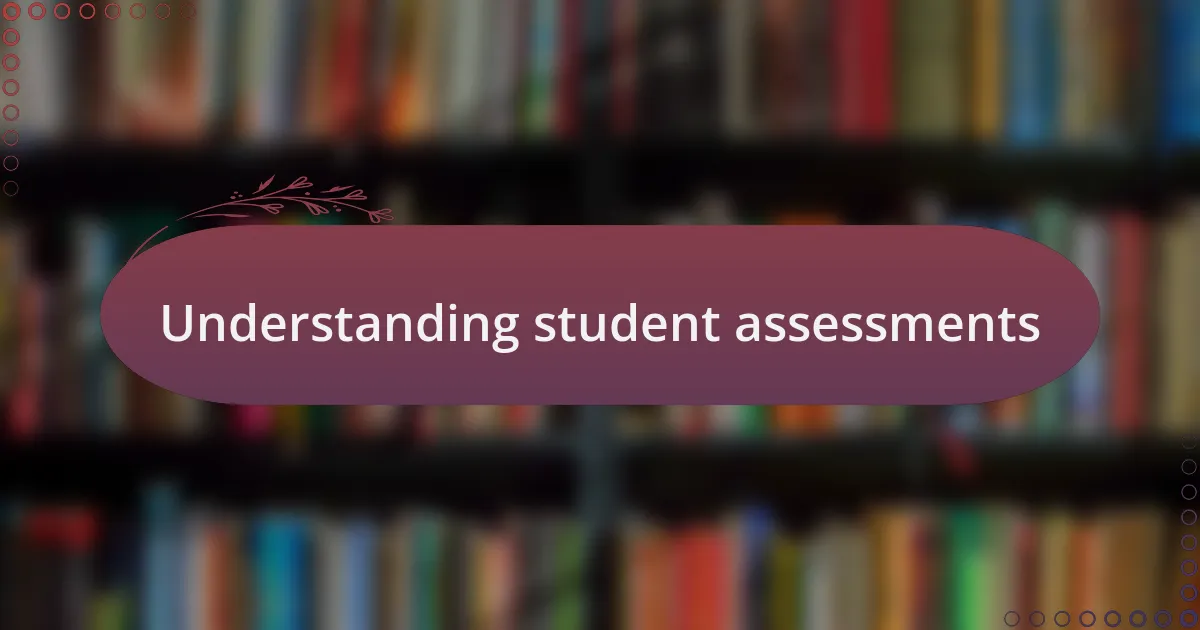
Understanding student assessments
Student assessments play a crucial role in the educational journey, providing insights into what learners truly understand. I remember a student who struggled with traditional testing methods but thrived when given alternative forms of assessment, like projects and presentations. Isn’t it fascinating how diverse assessment types can reveal different strengths and weaknesses in students?
When I think about assessment, I often reflect on how challenging it can be for both educators and learners to navigate. Have you ever noticed that some students get anxious at the thought of a test? Understanding this emotional aspect is essential, and it drove me to explore more engaging and supportive assessment methods, ensuring that every student felt valued and capable.
In my experience, assessment isn’t just about grades; it’s a tool for growth. I found that when I involved students in crafting their own assessments, often through self-evaluation or peer feedback, their engagement and ownership of learning soared. How empowering is it for students to have a say in how they demonstrate their knowledge? It transforms the assessment experience into a collaborative journey rather than a mere judgment.
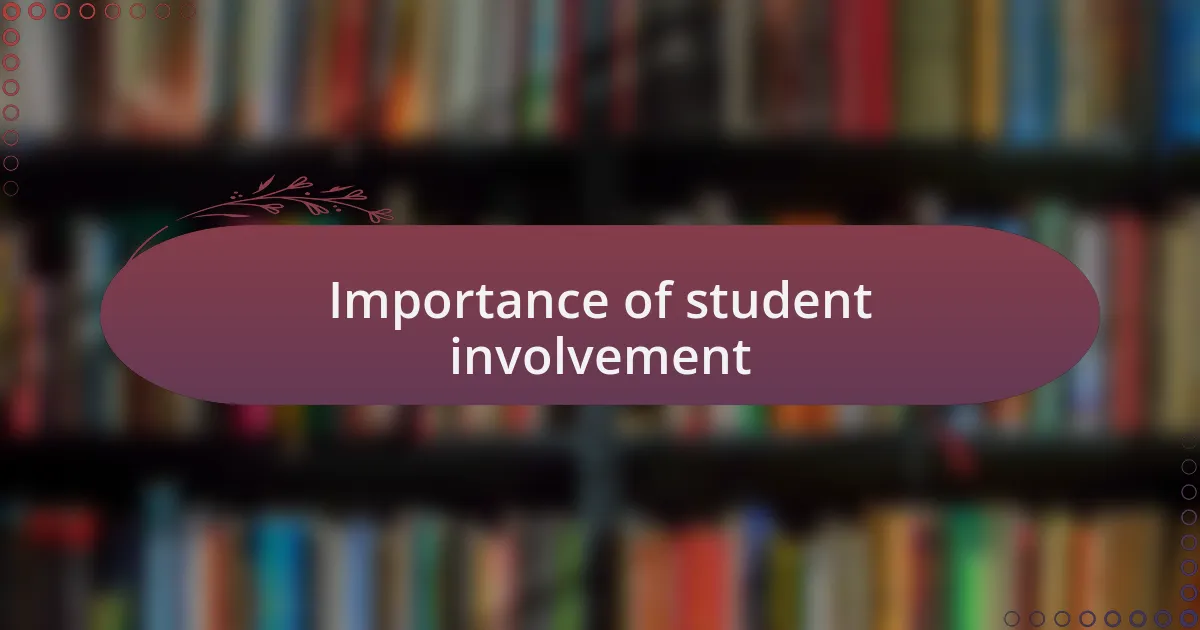
Importance of student involvement
When I think about the importance of student involvement, I recall a group project where students had the freedom to choose their topics. The excitement was palpable—they took ownership and delved into their research with enthusiasm, which made the learning process much richer. Isn’t it remarkable how giving students a voice can ignite their passion for knowledge?
In my experience, involving students in assessments also fosters a sense of responsibility. I once had a student who initially struggled with his grades but thrived when asked to create a rubric for his project. Watching him take pride in his work was a powerful reminder of how engagement in the assessment process can lead to improved self-esteem and performance. Have you ever seen the spark in a student’s eyes when they feel empowered?
Moreover, student involvement instills a culture of collaboration. I remember a classroom where peers would discuss their assessments openly, sharing feedback and ideas. This not only built a supportive community but also allowed them to learn from one another, enriching the educational experience. Doesn’t it make sense that such interaction can lead to deeper understanding and lasting connections among students?
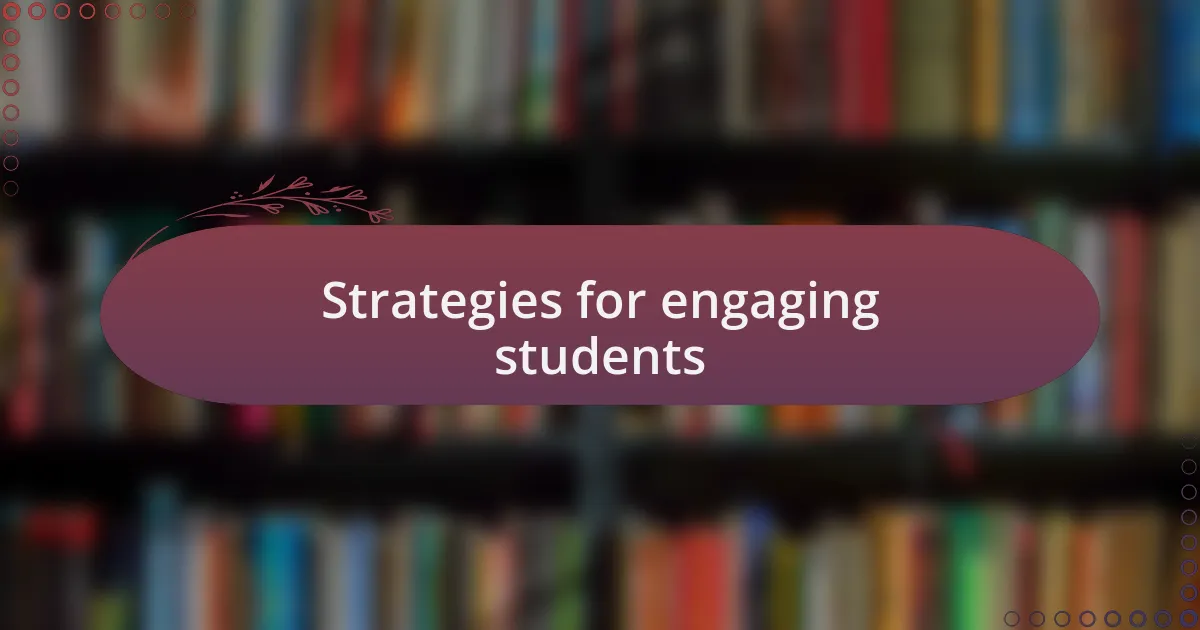
Strategies for engaging students
Engaging students effectively can begin with the power of technology. I once integrated a class project with a digital platform where students could showcase their work through multimedia presentations. The enthusiasm was infectious; they poured their creativity into videos and websites, transforming a standard report into a dynamic expression of their ideas. Have you noticed how technology can breathe new life into traditional assignments?
Another approach I’ve found useful is incorporating peer assessments. I remember hosting a session where students critiqued each other’s work using guided questions. It was eye-opening to witness their deep insights and candid feedback. This not only sharpened their analytical skills but also fostered a sense of camaraderie; they were learning from their peers while building a community of trust. Wouldn’t you agree that learning alongside each other often leads to more profound realizations?
Lastly, I have had success with choice boards, which allow students to select how they want to demonstrate their understanding of a topic. One student, who usually shied away from participating, chose to create a podcast instead of giving a traditional presentation. The pride in her voice was undeniable, and it highlighted how choice can encourage even the most reserved students to engage authentically. Isn’t it fascinating how providing options can reveal talents we never knew existed?

Creating collaborative assessment projects
Creating collaborative assessment projects can be one of the most rewarding experiences for both students and educators. I vividly remember a project where my class divided into small groups to create a documentary on a historical event. It was incredible to see how each student took on different roles—researcher, scriptwriter, or editor—and engaged in lively discussions about their findings. Do you think students realize how much they learn from each other during these collaborations?
In another instance, I introduced a joint project that required students to work with a class from a different school. They utilized video conferencing tools to share ideas and combine their efforts, which fostered not only academic collaboration but also friendships across distances. I found that when students connect beyond their immediate environment, their perspectives broaden, and they become more invested in the work. Have you ever watched students light up when they discover a new viewpoint?
Facilitating these collaborative projects does take planning, but the outcomes can be transformative. For example, I guided my students in creating a community service initiative where they assessed local needs and designed solutions together. Seeing their passion for making a difference was inspiring; it sparked discussions that extended far beyond the classroom. Isn’t it amazing how collaborative projects can empower students to take ownership of their learning while instilling a sense of responsibility?
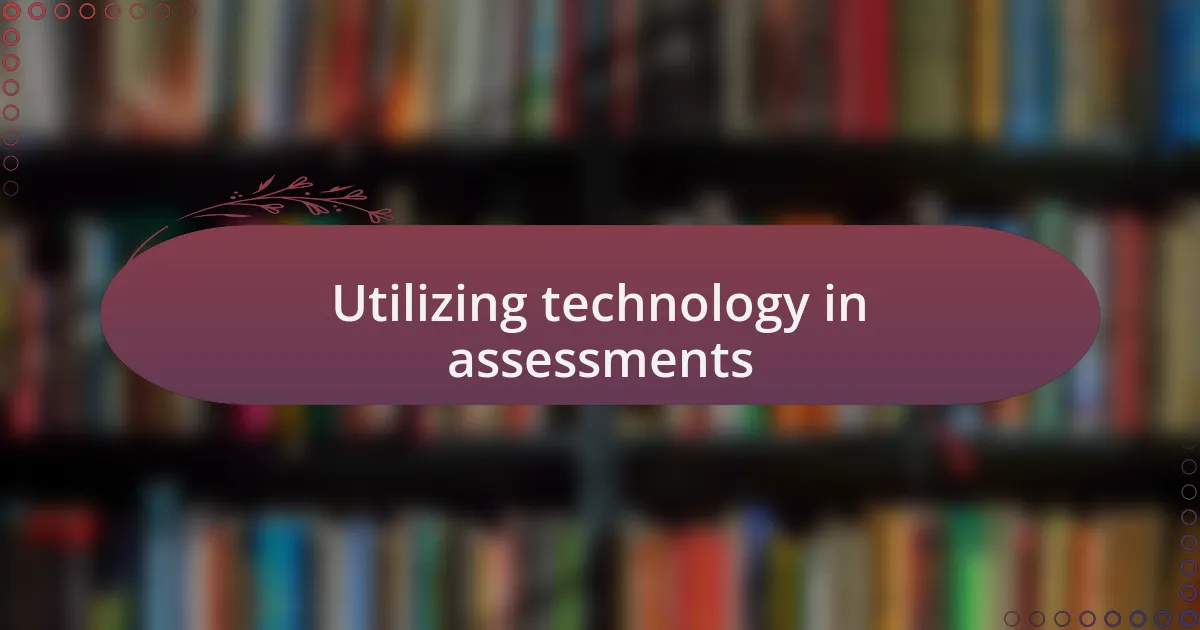
Utilizing technology in assessments
Utilizing technology in assessments has opened up exciting possibilities for student engagement. For instance, I once used an online quiz platform to create interactive assessments that offered instant feedback. This not only gamified the experience but also motivated students to improve their performance continuously. Isn’t it fascinating how technology can turn an ordinary test into a dynamic learning experience?
Moreover, I’ve found that digital collaboration tools can significantly enhance peer-assessment activities. After introducing a shared document platform, students were able to review each other’s work, leaving comments and suggestions in real-time. It was rewarding to witness their growth as they learned to give and receive constructive feedback. Have you noticed how much more invested students can become when they feel their voices matter?
Finally, exploring data analytics features that many educational tools provide has given me deeper insights into student performance. By analyzing trends from their assessments, I’ve been able to identify areas where specific support was needed. It’s empowering to see how targeted interventions can help students thrive—don’t you think harnessing data in this way transforms our teaching approach?
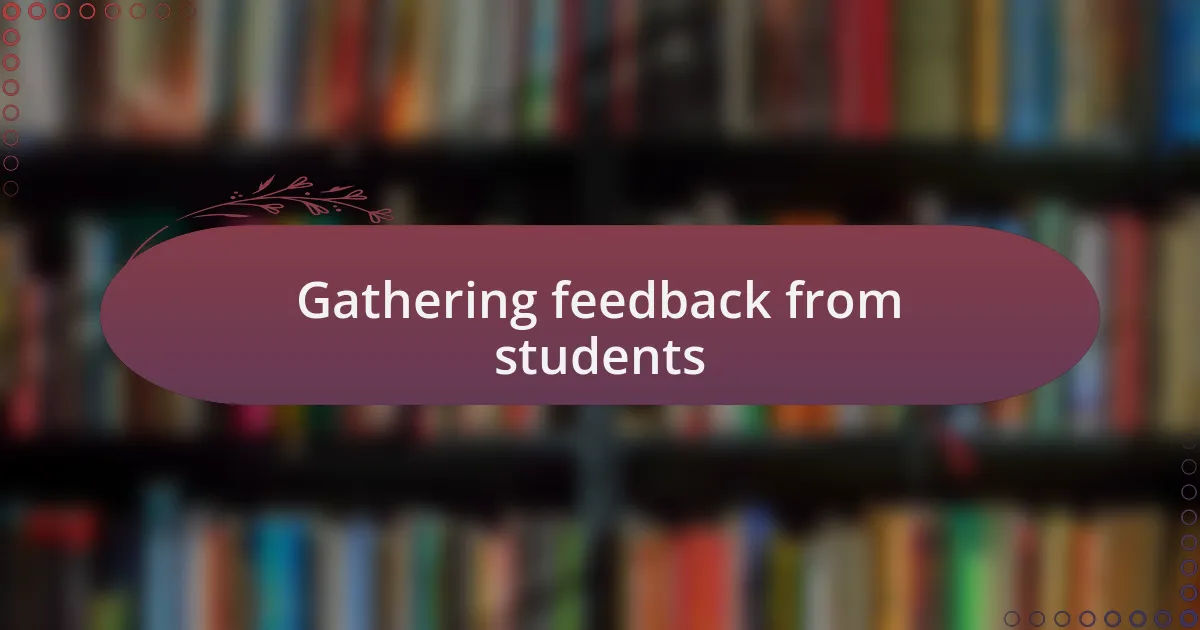
Gathering feedback from students
Gathering feedback from students is essential for refining the assessment process and tailoring it to their needs. I remember setting up an anonymous feedback form after a major project. The honesty in their responses was eye-opening and valuable, allowing me to identify areas of confusion and topics where they felt more guidance was necessary. Isn’t it incredible how students can provide fresh perspectives that even seasoned educators might overlook?
One time, I decided to hold a feedback session where students openly shared their thoughts on an assessment’s design. I felt a mix of excitement and apprehension in the room, but the rich discussion that ensued was worth it. Students highlighted which elements they found challenging and which parts they enjoyed. Their input sparked meaningful changes that genuinely improved future assessments. Have you ever witnessed the power of student voices in shaping learning experiences?
Lastly, I find that incorporating regular check-ins throughout a course works wonders for collecting feedback. Simple, reflective queries during class can help students articulate their feelings about the evaluations. I recall a particular session where students expressed concerns about timing, leading to adjustments that benefited everyone. It’s these small yet impactful conversations that reinforce the idea that feedback is a two-way street—do you see how fostering this dialogue can enrich the learning environment?
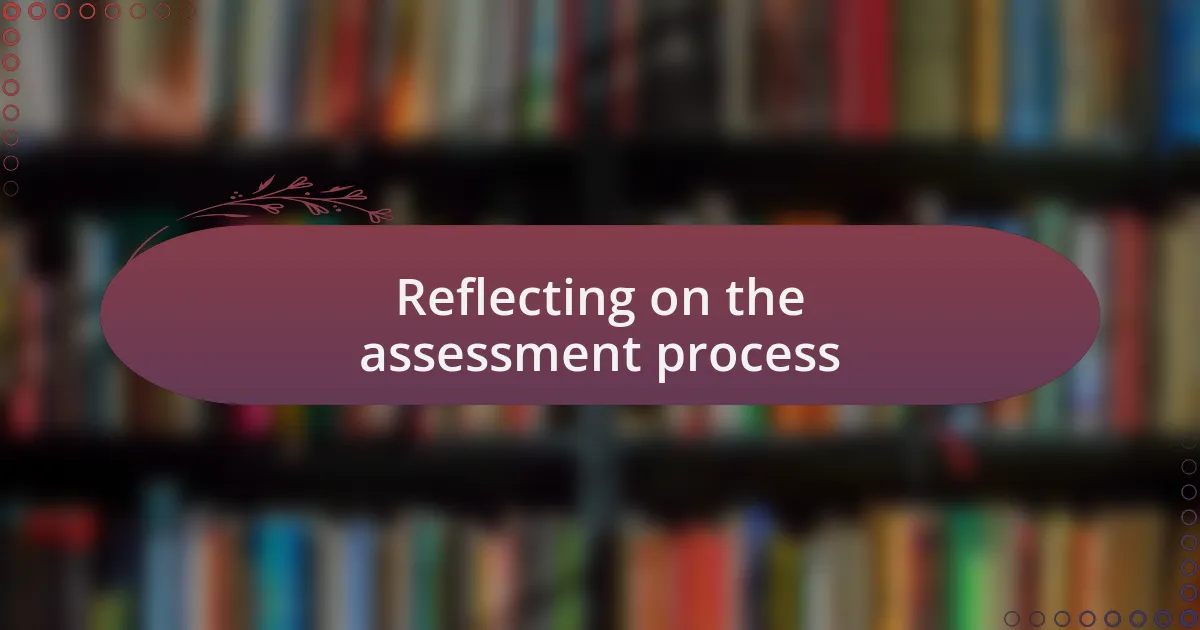
Reflecting on the assessment process
Reflecting on the assessment process allows me to pinpoint what truly works and what doesn’t for my students. After each assessment, I take time to analyze how students performed and what adjustments could facilitate better understanding. I still remember the frustration of seeing a few students struggle despite their efforts. It was a stark reminder that assessment isn’t merely a grade—it’s an opportunity to learn and grow.
One particular instance stands out in my mind. I had used a new evaluation format that, while innovative, seemed to leave some students bewildered. Their confusion catalyzed a deeper reflection on my part. I realized that assessments should not only test knowledge but also serve as a bridge to future learning. By revisiting this assessment with a critical eye, I could refine my approach and ensure clarity for my students. Isn’t it fascinating how our reflections can transform our methods for the better?
Moreover, I discovered that sharing my reflections with students creates a rich learning environment. When I talk about my thought process behind an assessment, it demystifies the grading system for them. I once shared how I shaped a project based on their past struggles, and their reactions were priceless—seeing that they were not just passive recipients but active contributors to the assessment framework invigorated the classroom dynamic. Have you ever experienced the satisfaction that comes from transparent discussions about learning and assessment? It’s moments like these that solidify the partnership between teacher and students.